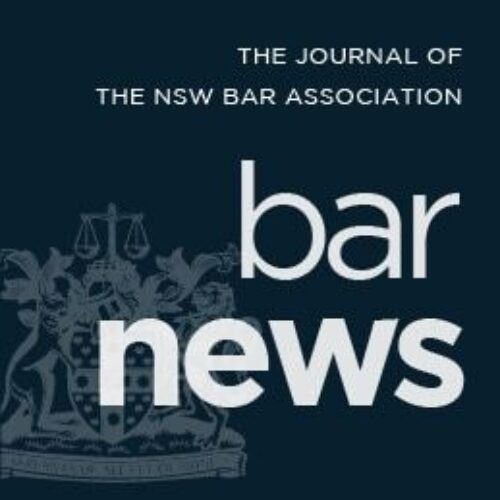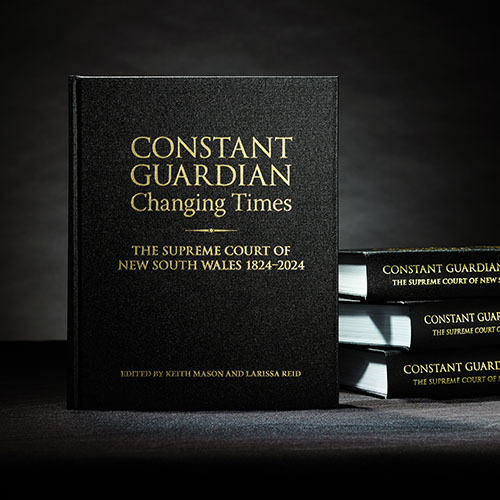- Winter 2024
- The first two centuries Speech from the launch of Constant Guardian, Changing Times: The Supreme Court of New South Wales 1824–2024 (Keith Mason and Larissa Reid, eds)
The first two centuries Speech from the launch of Constant Guardian, Changing Times: The Supreme Court of New South Wales 1824–2024 (Keith Mason and Larissa Reid, eds)

At the outset, I thank Chief Justice Bell for inviting me to launch this volume. It is quite amazing how you managed to engineer this project.
In preparation for this occasion, I read the text in proof copy. The process of reading was a delight. The writing is clear, devoid of cliches, and the array of photographs enlivens and adds depth to the text. It is a magnificent testament to the significance of the bicentenary of the court.
As is recognised in the book, during my term of office I delivered speeches and published articles which referred to a wide range of the aspects of this court’s organisation and activities. The importance of the historical continuity of our legal system was one of the dominant themes of my 13 years of public engagement as Chief Justice: from my swearing-in, through the 175th anniversary of the court, and in every one of the 900 or so times I repeated my standard address of welcome at admission ceremonies. When I come to meet my maker, I will have to explain why I admitted about 15,000 new legal practitioners. My only defence will be that half didn’t take out practising certificates.
Despite my past immersion in these topics, reading this volume has been revelatory. I learned something new on virtually every page of the text. I congratulate and thank the authors of the respective chapters and, especially, the editors, Keith Mason and Larissa Reid, who brought it all together.
There is one quotation, which I had not come across before, and which could serve as an epigraph for this volume. Sir Victor Windeyer once commented on the traditional clothing of lawyers and judges. He said:
The observance of old forms and customs is not simply a conservative adherence to usage. It is more, for it is a manifestation of the continuity of the law of the land. The present is visibly linked with the past, as a firm basis from which the development and reform of the law can proceed in response to new social needs.
This observation applies well beyond court dress. It applies to almost all aspects of the legal system, so comprehensively covered in this book. Beyond the detail, one can deduce two overriding consequences of continuity. First, there is an embedded wisdom in institutions which have grown and developed over long periods of time. Secondly, institutional longevity is a defining characteristic of a successful society, because stability enhances the level of trust.
An excellent example of the social contribution of the continuity of the law is manifest in two related judgments of Forbes CJ, the first Chief Justice of the court, under the New South Wales Act 1823 (UK), which established both the Supreme Court and the first Legislative Council, which could enact legislation. However, all legislation was subject to a ruling by the Chief Justice that the Act was not repugnant to the laws of England. In essence this was a one-sentence Constitutional bill of rights. Permit me to observe that I have written about a ‘common law bill of rights’, which was inherent in this provision.
A year after the court commenced, Forbes CJ had to rule on Governor Darling’s attempts to control the increasingly intrusive local media, particularly The Australian, established by the first two London-qualified barristers of this court: Wardell and Wentworth. That Act required all papers to be licensed. Forbes CJ struck it down as repugnant to English law.
The Governor then imposed a stamp duty on newspapers, which would have crippled their operation. Under the New South Wales Act 1823 (UK), the Legislative Council had authority to impose taxes for certain purposes. The stamp duty Act expressly stated that its purpose was to raise funds for public works. Forbes determined that the true purpose of the tax was to destroy certain newspapers. It was struck down.
Freedom of speech was established as a fundamental value, even when we were, in essence, a military regime. From the outset, this court was a Constitutional court. I note that it took the High Court about a century to reach similar conclusions about the Constitution of the Commonwealth.
The common law of Australia has long since developed from the common law of England. However, there remain ties that retain utility. For example, both Chief Justice Bell and I are members of Lincoln’s Inn, as Chief Justice Forbes was two centuries ago.
Each of the 17 separate chapters in this book covers the historical origins of the subject topic and set out how that aspect of the law has adapted to changed social circumstances. The ability of our legal system to innovate and reform was apparent from the outset. Convicted felons could not sue in English law; that wouldn’t work in a convict colony. This volume definitively identifies the ability of the court to ensure that its procedures and substantive law remain relevant and effective. I accept that this process was not without diversions and delays.
The fundamental focus of the book is the Supreme Court. However, it is also about the role of the law in our society and how that society has changed over time. As such, it is not just a legal history. I have no doubt that it will be used as an educational text for a much broader sphere than legal education. That is particularly apparent in chapters such as those on famous criminal cases, Indigenous peoples and women. Each of them reflects the prejudices of the time and shows how attitudes have changed and court practice has adjusted.
The understanding of continuity in the structure and the content of the law underpins the stability of our social life in all its manifestations. That common knowledge is reinforced by the inheritance of legal terminology, which does not fluctuate in the confusing manner of other spheres of public discourse. Two recent examples will suffice.
For most of my public career, the word ‘elite’ was a left-wing term of abuse. It has transmogrified into a right-wing term of abuse. More recently the word ‘woke’, which began life as a reference to an awakened recognition of racism by Black Americans, has been taken over by those who think that such recognition is wrong or, at least, has gone too far. Perhaps we should be grateful that ‘woke’ appears to have completely replaced the sarcasm of ‘politically correct’ as a term of abuse.
I recommend this book to every practising lawyer and judicial officer. I have one minor qualification. In the overview chapter on the second century of the court, there is a discussion about the jurisprudential distinctiveness of New South Wales. I refer to the strength of equity scholarship over the entire two centuries, perhaps most clearly under Chief Justice Jordan and thereafter.
This state and this court retained the structural separation of equity from common caw procedure for almost a century after their merger by the Judicature Acts in England, which were quickly adopted by other states in Australia.
After New South Wales finally brought the jurisdictions together, there remained a passionate resistance in this state to any suggestion that this could affect the substantive law of equity. This was rejected as ‘the fusion fallacy’.
That was part of my education at the University of Sydney Law School, where the lecturers included Roddy Meagher, John Lehane, and Bill Gummow.
I was surprised by a passage in chapter 2, on the second century, which characterised the commitment to the traditions of equity as a preference for ‘historical distinctions’ over ‘coherence and rationality’.
My own background rejects the suggestion that an emphasis on the distinctiveness of equity was either ‘incoherent’ or ‘irrational’, let alone both. I knew that the co-author of this chapter, Keith Mason, had bitten from the restitution apple. My surprise arose because the other alleged co-author of this chapter was said to have been Justice Mark Leeming, the very editor of the updates to the sacred text by Meagher, Gummow and Lehane. I do not accept the attribution of co-authorship in this respect.
This book provides an excellent and comprehensive background to the celebration of the court’s imminent bicentennial. It adds depth of a kind that the court did not attempt in the celebration of the 175th anniversary in 1999. Those who were present for the ceremonial sitting of the court on that occasion will recall two distinctive features.
First, Mr Barker QC and Ms Hole, respectively the presidents of the Bar and the Law Society, surrendered their usual role of addressing the court at a ceremonial sitting. The former prime minister, Gough Whitlam QC, spoke for the Bar and the serving prime minister, John Howard, formerly a solicitor, spoke for the Law Society.
Secondly, before the addresses by Whitlam and Howard, an Aboriginal woman delivered a Welcome to Country. This practice, with which we are all now familiar, was virtually unknown in 1999. The book I am launching describes the reaction of an overflowing Banco Court as ‘you could have heard a pin drop’. I confirm that I have never experienced silence like it.
I had only told two people of this addition to the usual agenda: Keith Mason, as the second in seniority in the court, and John Howard, who had recently been the target of Indigenous protests. I knew I didn’t have to seek the consent of my former boss, Gough Whitlam.
This was the first time in Australia that such a welcome had been delivered on an official occasion. The President of the Legislative Council later informed me that the court’s precedent was what enabled this practice to be adopted in the New South Wales Parliament.
Finally, I repeat the reference with which I concluded my address at the 175th anniversary. In his judgments, Chief Justice Forbes had acknowledged that, for thousands of years before the arrival of British justice, Indigenous Australians made and enforced the laws in this land. That is a recognition that the court, admittedly after a long gap, now acknowledges, as recognised in the Indigenous chapter of this volume.
There is no tradition about a physical act to announce the launch of a book. Not cutting a ribbon, nor smashing a champagne bottle, not even a toast. As we are in a court, I recognise and thank the editors, Keith Mason and Larissa Reid, with a bow.
This book is launched into the court’s third century.

